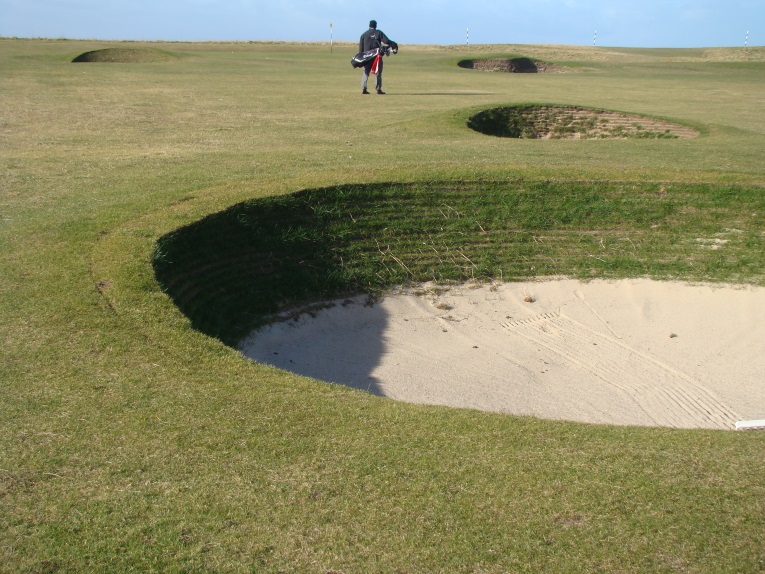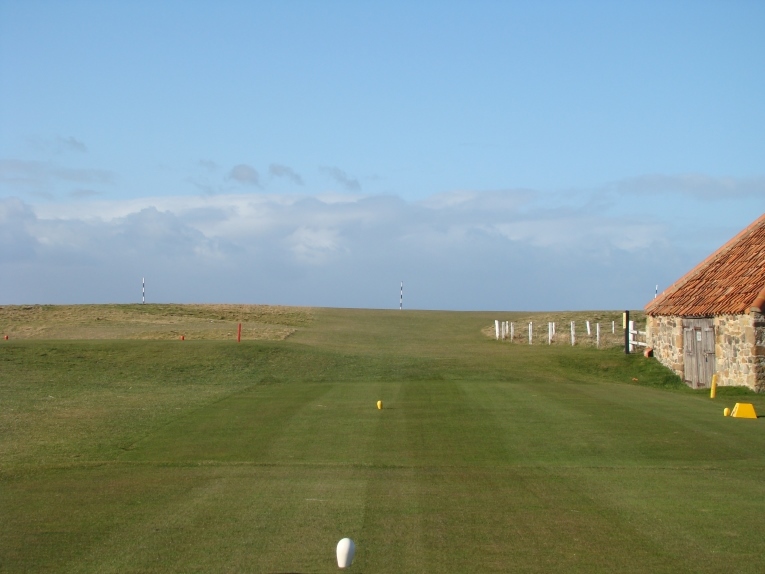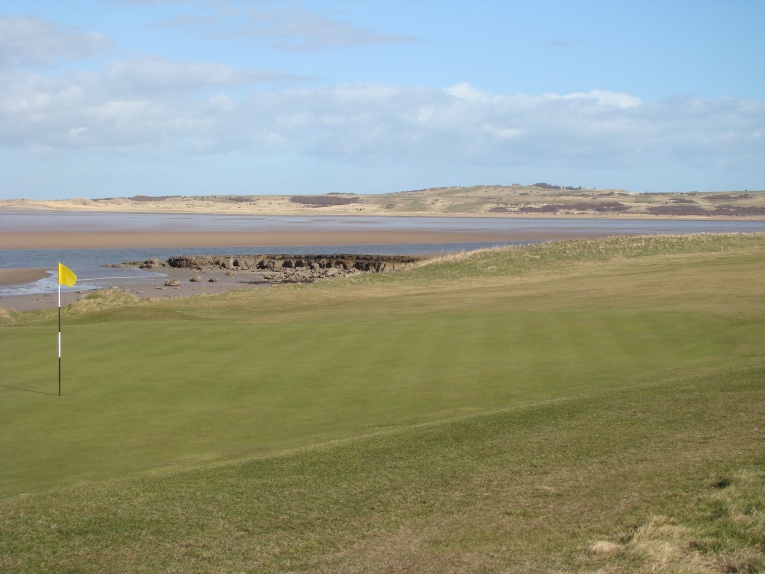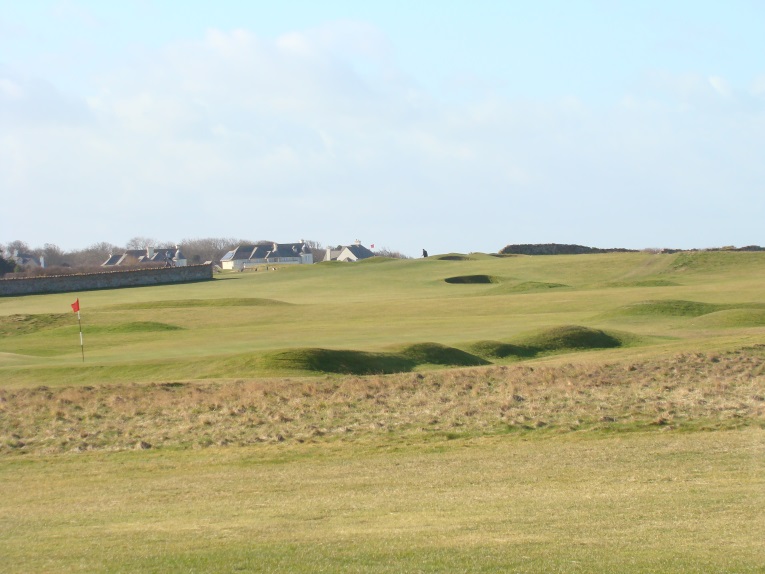Kilspindie Golf Club
East Lothian, Scotland

Kilspindie occupies a wonderful, unspoiled strip of land along the Firth of Forth. The course’s meager 5,500 yards belies the range of shots required.
Kilspindie Golf Club, tucked away in that golfing corner known as East Lothian, offers great insight into the evolution of the game. Golf has been played at Kilspindie since the late 1890s courtesy of designs by Ben Sayer of North Berwick and Musselburgh’s Willie Park Jr.. Several holes have been altered but these two titans deserve credit for fashioning the course that is enjoyed today. Gorgeously situated on a compact 70 acre block of land that protrudes into Aberlady Bay, the course is fronted by water on three sides. Sweeping, long views across the Firth of Forth dominate the scene and one’s overall perception of the course. The fortuitous siting also means that the club’s property is hemmed in and that the course never had an opportunity to expand. The gutta percha ball was in play when Kilspindie opened and the windswept 5,200 yard course was more than enough to challenge the best. Today, the par 69 course measures 5,500 yards and no more.
Kilspindie is a prime example of why ‘par’ is meaningless. The concept of ‘par’ is a fairly recent innovation whose sole purpose is to provide a convenient method of keeping score (easier on one’s mind than ‘level fours’). In both match play and stroke play success is determined by the number of strokes taken, regardless of “par.” In match play a four bests a five and in stroke play 284 defeats 285. Does it matter if 284 represents a score of even par, four under par or four over par? Of course not. Some could argue that a golfer might play a 475 yard hole par 4 hole differently if it were deemed a par five. Such a player is either foolish or of weak mind if a number on a card dictates his play.
Alas, those who cherish par are unlikely to even play the 5,500 yard Kilspindie, especially since the course features six par fours measuring less than 300 yards. This cannot be proper golf, they sniff. More is the pity, as they will miss a real treat. Notably, the authors know of no other course in the British Isles where it is readily possible on four holes (2, 3, 4 and 8) to splash a shot in salt water – not the beach or rocks – but the actual water. Save for the ninth tee there is no place to hide from the wind, often a fierce sea breeze.
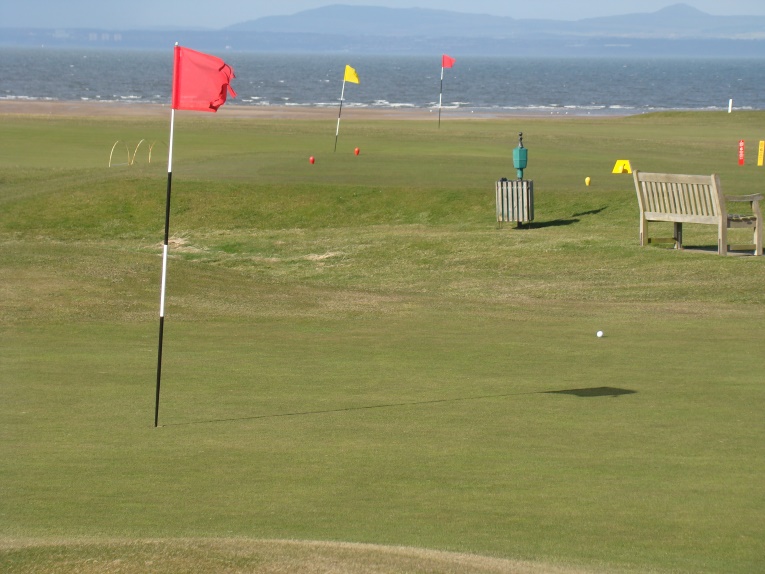
Situated on 70 acres, the holes are tightly knit and eighteen holes can be enjoyed in well under three hours.
How about those painfully short par fours (7 if we include the ninth – 310 yards)? Five of them (5, 9, 11, 12, 18) play predominantly west to east with the prevailing wind, while the other two (6 and 17) play into the wind. Staunch defenders of par might assert that such a plan is the height of folly as those short holes will now be lesser still (indeed, in a particularly strong wind one author found his three-wood to be too much on several of these holes and a 4-iron (!) too much on another (the eighteenth). Nonetheless, the authors maintain that 5,500 yards does not guarantee a bunch of simple, short approaches for the good player. Far from it, the author approached more greens here with long irons and three woods than he did the following day at Muirfield. Think about that! Without wind these modest holes become routine drive-and-pitch holes. Downwind, the good player must find the green from some 290 yards – a challenge he relishes. If one ignores par these holes become great fun and create tremendous interest. The Home hole, for example, is 250 yards long but the tee shot across the corner of the wall to a green smack in front of the clubhouse is a very demanding yet appealing stroke. If the club were to make the ‘4’ on the card a ‘3,’ the hole might be regarded as one of the strongest finishing holes in Scotland but in reality would be unchanged and the same stern challenge. The short two-shotters that play into the breeze were designed with that in mind. The sixth green is fronted by the deepest greenside bunkers on the course and the pitch to the seveteenth is played across bits of an old stone wall. Both require lofted approaches, and the headwind makes such more feasible. The downwind holes are appropriately open in front but tightly protected on the sides, making for difficult and interesting second shots.
It is unconventional but great fun is crammed into these 5,500 yards, as we see below. American golf architect Todd Jerome has lived in Aberlady for 11 years and been a member of Kilspindie since 2007. He remains as keen for a round today as when he joined. Regarding its enduring merits, he opines,
There should be more courses like Kilspindie designed and built, but the challenge of convincing a big developer to buy into 5,500 yards is not something many would dare to take on. However, how many golfers do you know that would agree golf would be better with more Kilspindies in the mix. “Fun” has become a more and more popular description for a golf course design, but that’s obviously a very subjective term – even more so than “minimalist”– and for many golfers the new “fun” courses are actually long and hard. For a very wide swath of golfers, Kilspindie would earn the description. Play at Kilspindie is quick, interesting, demanding, thought provoking, beautiful, walkable, birdie-able, endless variety, dog friendly, welcoming and well, it’s fun. When I first started playing Kilspindie fresh out of the golf course masters program I built up quite a mental list of all the things I would change; starting with a par 3, the immediate routing to the coast line, four difficult holes to start the round, its simplistic green design, its length, its small bunkers, tees on top of green, so many short par fours – and the wind. It didn’t take long to realize the wind was going to be a constant so I would have to learn to hit the ball lower, or better yet on the ground. As for the rest of Kilspindie’s “flaws” I began to recognize them as central parts of the overall enjoyment of a round there, and they are now features I relish.
In addition, it’s worth noting that Kilspindie is a wonderful, fast draining winter course. The pictures in this profile were taken in early March and reveal the fine conditions one may expect year around.
Holes to Note
First hole, 165 yards, The Point; Opening with a par 3 is certainly unusual but in this case especially pleasing as the first shot of the day is played with stunning views all around. Most admirably, it gets the player to the Firth as quickly as possible.
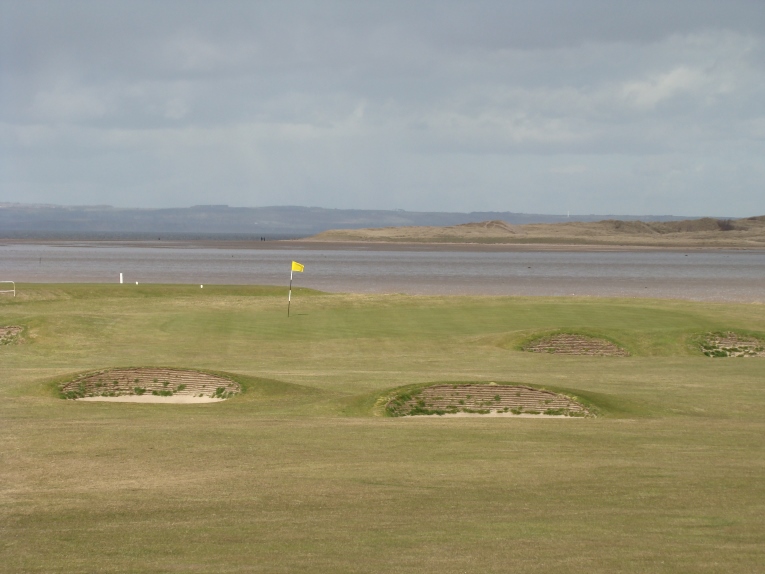
The short first makes a beeline for the Firth. Gullane Hill is one mile across the bay to the right.
Second hole, 515 yards, Kings Kist; This is the only three shot hole on the course. It’s routed into the prevailing wind and some members will tell you that the course doesn’t have a 5 par, only a par 6! Every shot is appealing; the tee ball bends right around the Firth, the second that must avoid several nasty bunkers, and the approach is to a smallish green with a good amount of back to front tilt.
Third hole, 415 yards, Arthur’s Seat; Kilspindie’s terrain isn’t as rumpled as Brora’s but it features broad slopes similar to nearby neighbor, Muirfield. Similarly, the player usually has a good view of what he is trying to accomplish but this tee is a wonderful exception. An upslope blocks all of the fairway unsettling the golfer who understands that the perilous shore is hard along the right. Watching your tee ball flighted low under the wind and just right of the directional marker is a thing of beauty. It also affords the golfer the best approach into the narrow but deep green. The green’s tilt from left to right makes approach shots from the left rough problematic. Jerome makes note of Kilspindie’s rectangular greens, like the one here, that add to the course’s old world charm.
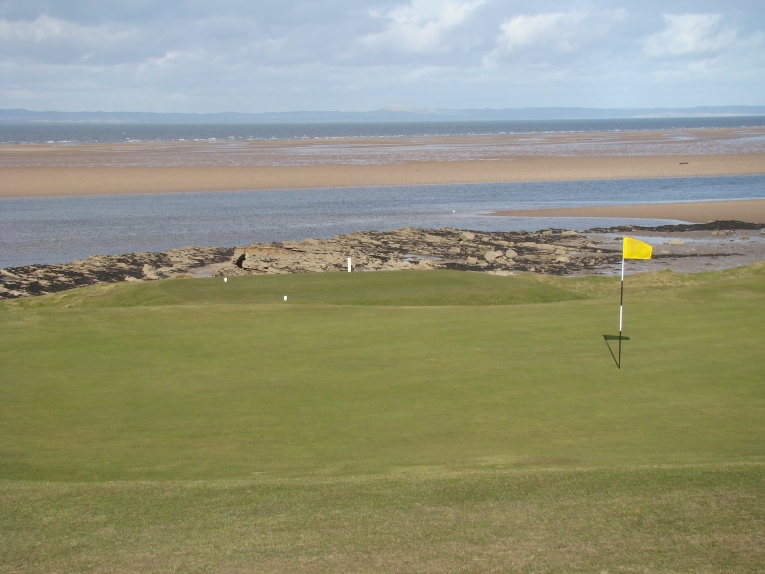
The proximity of the third green to the next tee highlights one of the reasons why Kilspindie is a quick playing course.
Fourth hole, 370 yards, The Target; After playing the fourth (or much sooner) the player will feel foolish believing Kilspindie to be merely a drive-and-pitch affair. With any wind, a player heading to the fifth tee only two over par is doing well. Played out to a point, with the Firth right and behind and Arthur’s Seat, a distant backdrop, the fourth epitomizes the reason so many people make an annual pilgrimage to Scotland. In fact, such picturesque holes are few and far between in these isles where dunes frequently separate the golfer from the water. Not here! Jerome considers the fourth right up there with the best holes in East Lothian, which is saying something. He once described it as ‘A short slight dog-leg right par 4 with Aberlady Bay along the right edge of the fairway and the green penetrating into The Firth of Forth on three sides.’ He concluded by noting ‘… you do not need length to pose a challenge.’
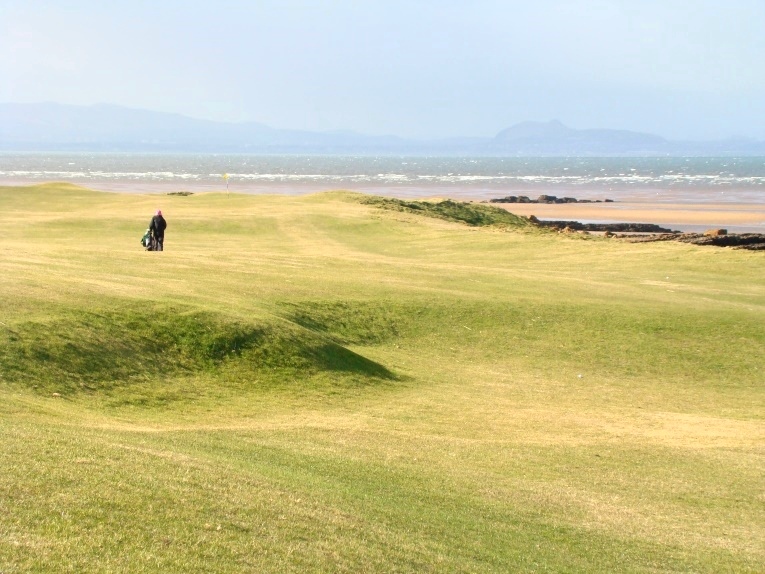
This depression was once a bunker that pinched the fairway to just fifteen paces from the shoreline.

The natural undulations around the fourth green are the best on the course and help elevate the hole to be among East Lothian’s finest.
Sixth hole, 280 yards, Green Craig; This is one of Kilspindie’s best sub-300 yard holes. Played into the prevailing wind, a tension always exists about how to execute one’s pitch: it has to be high enough to elude the three fronting pits but not so high so as to be gobbled up by the wind.
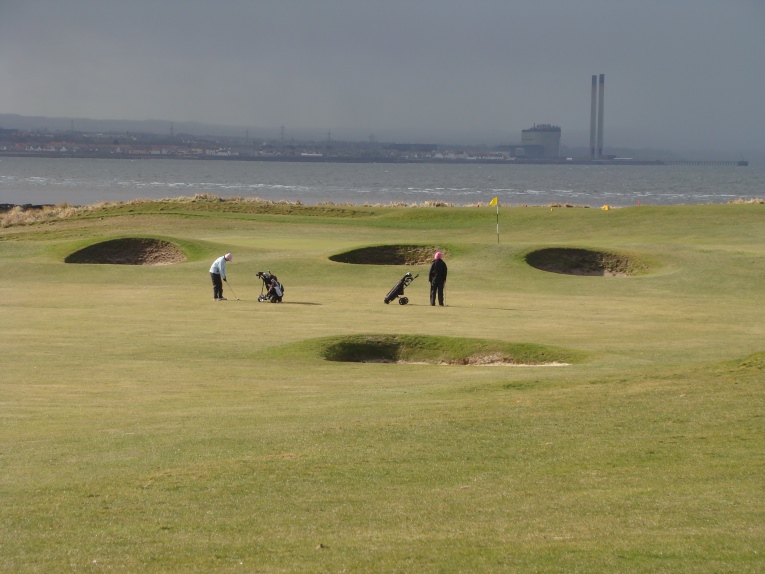
Many ways to work the ball close to the day’s right hole location, including the tight, short grass on the bank behind.
Eighth hole, 170 yards, Gosford Bay; This short hole – one of the game’s great unsung holes – plays across the water to a green perched some ten feet and protected by massive sleepers. Plenty of rough and clever contouring left of the green makes a three improbable for a safe shot bailed left. Similar to the mighty fifteenth at Portmarnock, the typical right-to-left wind requires the player to throw his tee ball out over the water, a soul-searching shot that calls for no small dose of courage. The list of one shotters in the United Kingdom and Ireland where one’s ball actually travels out and over a sandy beach is surprisingly short and without any doubt, the exhilarating eighth at Kilspindie proudly occupies a spot as one of best one shotters in the land.
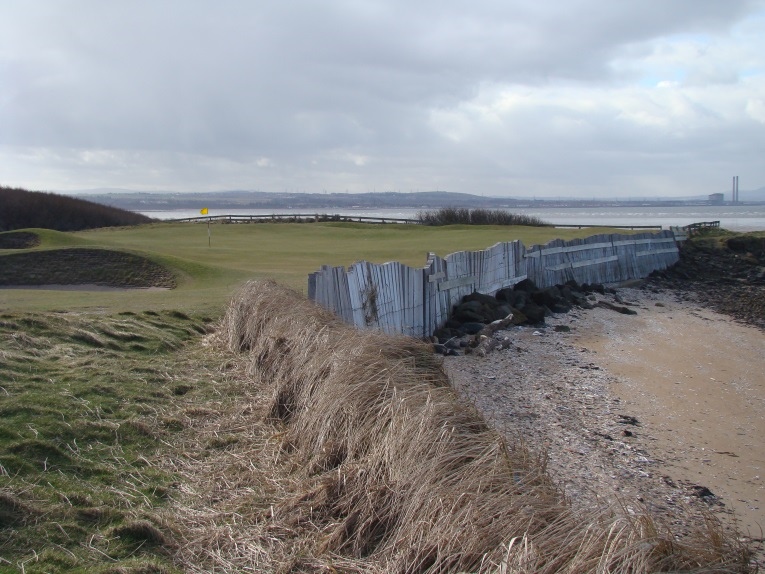
The flag doesn’t lie; generally, the wind whips from right to left here and exacerbates the hole’s challenge. The above photograph only hints at the green’s undulations. The putting surface is over four feet higher back left than front right, so sweeping breaking putts are also part of the equation.
Thirteenth hole, 180 yards, The Kirk; The hallmark of good architecture is getting the most out of the property’s features. The more diverse the features, the more singular the course. On the inward journey at Kilspindie, the golfer is removed from the coastline and the ground isn’t as crumpled as such gems as Brora and Fraserburgh. Nonetheless, a 200 year old plus boundary wall is neatly incorporated into play at three holes, namely here and the two closing ones. In all three cases, play commences on one side of the wall and finishes on the other.
Sixteenth hole, 410 yards, The Flagstaff; Links golf elevates itself above other forms by the delightful manner in which the ball interacts with tight fescue turf. As a prime example the sixteenth green follows the general slope of the land downhill, which is to say that the putting surface runs from front to back. How best to get an approach close? The answer varies wildly from day to day. On a rare calm day, the golfer might elect to carry his approach all the way onto the green. Typically, the strong wind demands a lower ball flight and some savvy members will land a low punch a good 50 yards short of the green and let the terrain do the rest. Watching a ball bumble along the ground over such a distance is sheer joy, an attribute rarely found outside of links golf.
Seventeenth hole, 280 yards, Craigielaw; The aforementioned stone wall tracks along the left of the fairway, then a 50 yard gap appears, before the former boundary wall continues. The green is cleverly located in the gap on the far side of the wall. A challenge, so novel, is rarely confronted and precisely why you should play Kilspindie.
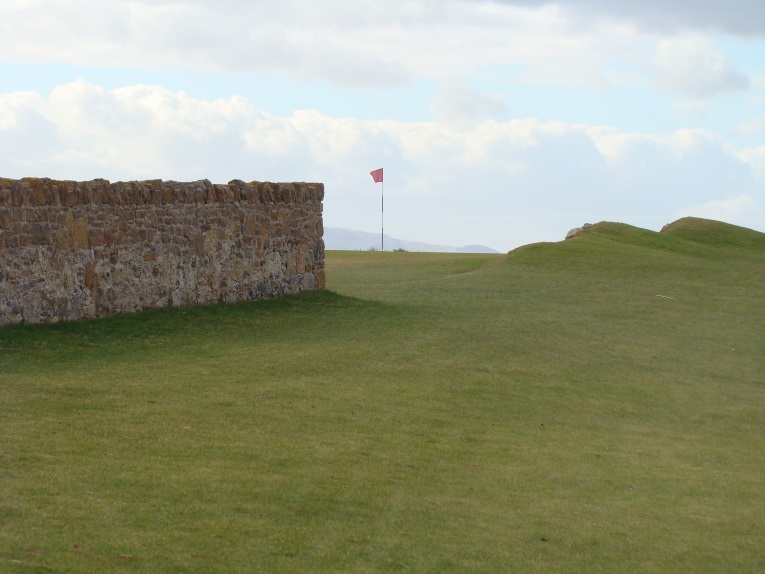
A gap in the wall allows the golfer a good view of the flag but not of the elevated green, which is a scant 23 yards deep.
Eighteenth hole, 250 yards, Home; Downhill and downwind, there are an amazing number of ways for the imprecise golfer to find himself hopelessly out of position. Clever bunkering and a green tilted toward the rear have cheated better players from a coveted ‘3’ for over a century. The clubhouse makes an attractive backdrop and one always senses that onlookers are there waiting for you to make a meal of the finesse shot required to get up and down.

Can the golfer play a precise draw from the tee? If so, he might be rewarded and see his tee ball find the putting surface. A more likely outcome is that he will be left with a fiddly shot of the sort that is the hardest to play deep into one’s match.
Rich Goodale, author of the Experience series on such famous links as Royal Dornoch and the Old Course at St. Andrews, considers Kilspindie thusly:
On a warm and calm Summer’s day, a modern pro could expect to break 60 at Kilspindie, given that he could conceivably hit twelve of the greens from the tee and the other six with two shots, only one or two of which would require much more than a wedge. A reasonably competent single figure handicap golfer could think of breaking 70, and even a hacker could dream of a score he had never before achieved. But even on such a day, all of those expectations would be achieved only if the player was fully on his or her game, and able to deal with the distractions of the vistas and the smells of the sea and the songs of the birds and the companionship and the intimacy of the course’s routing and the cunning subtleties of its design. More likely, the golfer would punctuate the final score (whether match or stroke) with a smile. And on those days when the wind arises and the sun is hidden behind low hanging clouds, and the holes into the wind seem endless and the holes downwind are fraught with unexpected danger, still the round will end with a smile. It is a magic place.
Indeed it is (!) though in fairness, the authors don’t mean to imply that Kilspindie is of the magnitude of Cruden Bay or Machrihanish. The first eight holes might belong in that conversation but the last ten are more pedestrian as they occupy less interesting land, devoid of random humps and bumps and without superlative interior green contouring. Still, there is much to be gleaned from a round at Kilspindie as the 35,000 Scots who enjoy it each year will attest. The ancient but timeless allure of chasing a ball across an intoxicating piece of windswept ground is alive and well here – an exhilarating experience that need not require a long trek (or take as long) as most golfers have become conditioned to believe.
Just be sure to leave ‘par’ in the boot of your car.
The End



